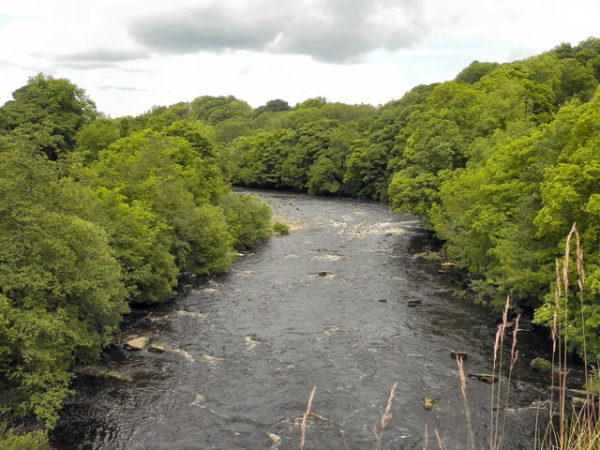Environment Agency water monitoring regime has been cut in half
“They just don't know the state of many of our rivers,” frontline environmental groups warn

The Environment Agency’s water quality monitoring programme has come under fire as data obtained by Unearthed shows the number of samples and sampling points has fallen by nearly 50% since 2013.
The steep decline has raised serious concerns over the state of England’s environmental regulation as it prepares for a dramatic change in the legal and regulatory regime after Brexit, with green groups calling for ring-fenced funding for “essential monitoring work.”
In 2013 the Agency took water quality samples at 10,797 sites and while that number gradually tapered off over the ensuing years, it dropped to just 5,796 sampling points in 2018 — nearly 40% less than the year before.
During the same period (13-18), the Agency saw the number of water quality samples fall by 45% – from 160,000 to 87,000 – due to a change in approach which the EA described as “greater targeting in an increasingly risk-based manner.”
The latest figures, some obtained by freedom of information and some provided by the EA, have seen civil society groups sound the alarm over the quality of England’s rivers and of efforts to bring them up to standard.
Stuart Singleton-White, head of campaigns at the Angling Trust, told Unearthed: “This dropoff in monitoring is incredibly concerning and very serious. Our rivers are deteriorating. The quality of rivers is getting worse. The number of pollution incidents seems to be increasing.”
It comes just as the government has delayed the release of a key report about the country’s water quality targets until after the election, according to the ENDS report.
Labour MP Mary Creagh, who led the Environmental Audit Committee when it investigated nitrate pollution last year, told Unearthed: “Our committee said a year ago that the EA doesn’t have the staff and resources to monitor water quality in the UK and these new figures show how that monitoring has fallen off a cliff in recent years. It is completely unacceptable.
“The Conservatives talk a good talk on the environment but time and again they fail to walk the walk and give our agencies the funding they need to do a good job.”
The Conservative Party failed to respond to a request for comment.
The EA – which is responding to extreme flooding in the north of England – said: “We target our monitoring resources using new and different tools and techniques better suited to getting evidence of environmental conditions. We take a risk based, targeted approach to delivering environmental improvements on the ground which will cause variations in the sample points monitored and sample numbers.”
Going backwards
These new stats support a long-observed trend in reduced Environment Agency capacity and activity at the frontline of environmental monitoring and inspection which may have contributed to surprise uptick in the number of serious incidents reported.
Last year Unearthed and the Telegraph reported that the EA had overseen a dramatic fall in the number of compliance inspections as well as significantly fewer prosecutions for environmental crimes — with nature groups saying the countryside was becoming ‘lawless.’
“The Environment Agency can’t say with any confidence what the state of our rivers is because they’re not monitoring them closely enough,” Singleton-White said.
“They are over reliant on organisations like the Angling Trust and our fisheries and indeed members of the public that report pollution incidents when they occur, rather than monitoring the rivers and preventing them from occurring in the first place.”
Mark Lloyd, chief executive at the Rivers Trust, echoed those concerns: “The current system isn’t working, and has deteriorated with budget cuts.”
When asked about the real-world impacts of the EA’s change in approach, conservation groups point to the UK’s below-average performance in meeting the targets of the EU’s water framework directive. The EU will cease to have enforcement powers over the UK after Brexit.
Only 14% of the rivers in England are classed as having ‘good ecological status’, down from 27% in 2010. This, experts believe, is having a knock-on effect on creatures that rely on our natural world.
Salmon, for instance, is ‘at risk’ or ‘probably at risk’ in 40 of the 42 principal salmon rivers in the country, though the EA notes that the struggles of salmon are global and partly a consequence of climate change.
Brexit
The Environment Agency’s efforts to tackle the floods in northern England have come in the midst of a general election that will determine the shape of Brexit and thus the future of the country’s environmental regulation.
Once it leaves the EU, its environmental rules – including the water framework directive – will be unenforceable at an EU level.
Ruth Chambers, an associate at Green Alliance, raised the issue of a strong post-Brexit green watchdog with Unearthed: “Chronic underfunding has plagued our environmental agencies for many years.
“The government has proposed new legal targets on water and biodiversity quality in its post-Brexit legislation. These must be set at a level that achieves significant improvement to England’s natural environment and should include restoring upland habitats which can help protect people better from serious flood events.
Without effective monitoring we can’t know what’s going on or whether the targets set are sufficient to drive progress. In the future, the government needs to ring fence funding for essential monitoring work.”
A version of this story featured in the Sunday Telegraph

